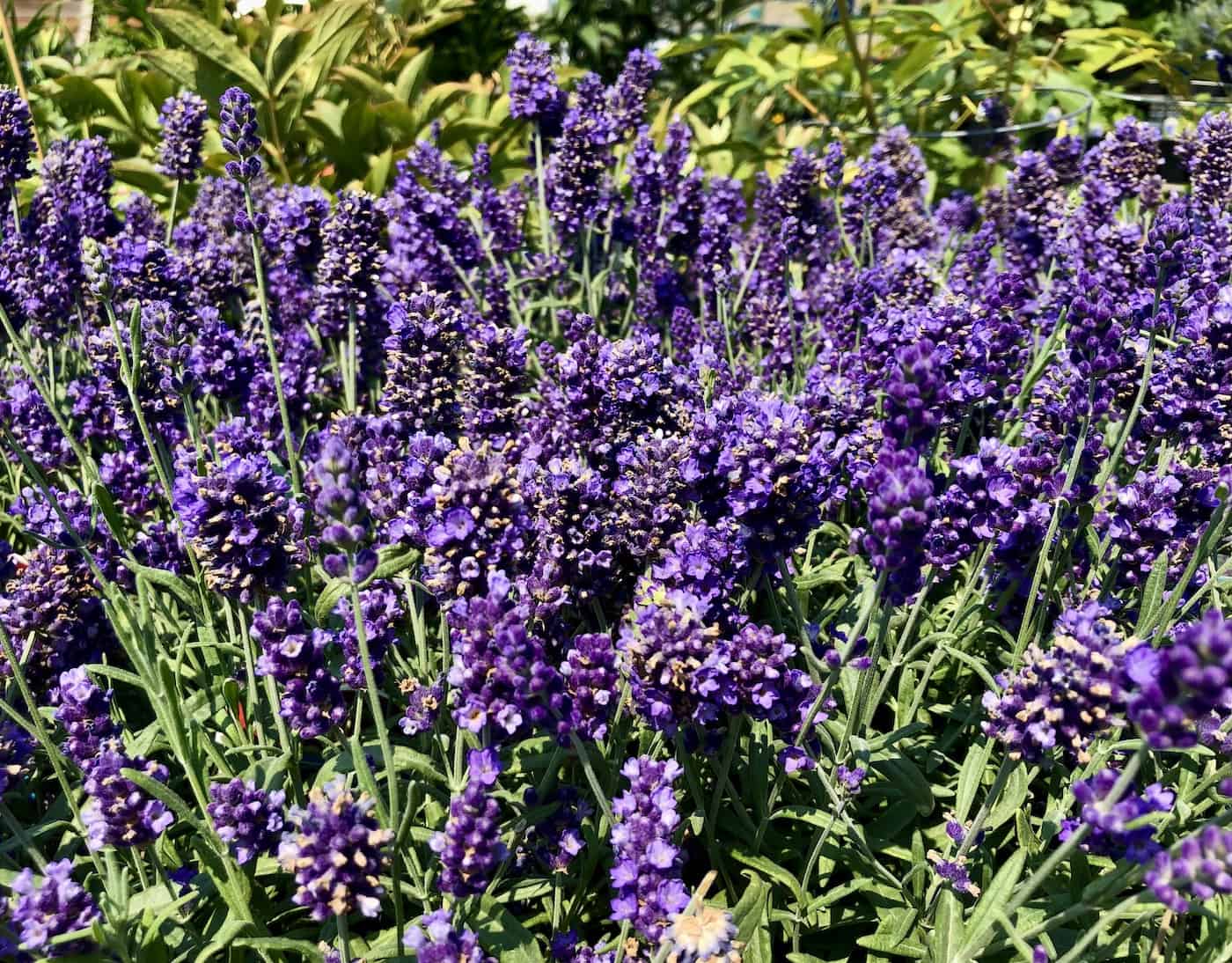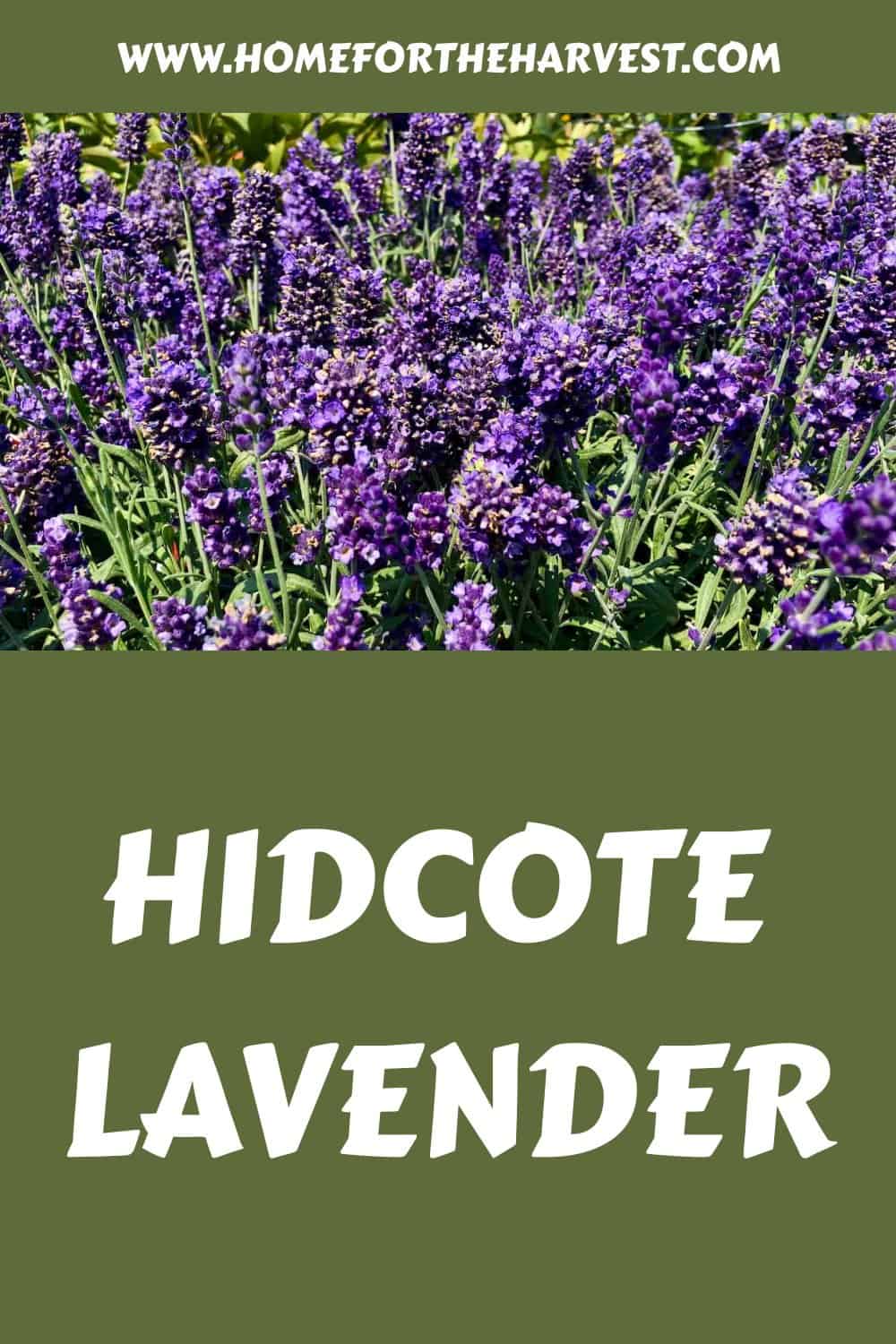Hidcote lavender is an heirloom variety of English Lavender known for its sweet scent, dark purple flowers, and compact shape. This drought-resistant variety can be grown in a wide variety of climates and tends to bloom in early summer.
Hidcote lavender grows best in sunny planting locations with sandy loam soil and is a good choice for a flowering deer-resistant plant. Annual maintenance includes watering regularly until the roots become established, feeding with a slow-release fertilizer in the spring, and giving the plant a hard prune in late summer/early fall after the flowers fade.
Hidcote lavender basics
Hidcote lavender (Lavandula angustifolia ‘Hidcote’) is an heirloom lavender cultivar known for its compact form, dense gray-green narrow leaves, and richly-colored deep purple-blue flowers. Bred by Major Lawrence Johnston in England, this variety is also highly fragrant with a sought-after sweet floral scent. Hidcote is one of the most famous varieties of English lavender available and received the RHS Award of Garden Merit in 1993.
Hidcote lavender can be planted alone as a compact feature plant, but its most common landscaping application is in mass plantings such as low hedges, border gardens, or a herb garden. Established plants grow to reach about 24″ tall (60 cm) at maturity.
These small evergreen shrubs are cold-tolerant in the range of Hardiness Zone 5-9 and are resistant to both deer and drought conditions. Its fragrant flowers are quite attractive to butterflies, hummingbirds, and pollinating bees. Hidcote can also be trained into tree form as a standard lavender topiary.
Hidcote lavender spikes are commonly harvested for their high-quality scent. The flower spikes can be used as cut flowers in fresh bouquets or dried for floral arrangements or potpourri. Dried Hidcote lavender is particularly dark purple in color compared to other varieties and tends to have a stronger sweet scent than most dried flowers. This variety is preferred for making dried lavender floral arrangements, crafts, perfumes, and potpourri.
“‘Hidcote’ was raised by Major Lawrence Johnston in the United Kingdom before 1950 and is a wonderful dark-flowered cultivar for ornamental use, hedging or feature plants and can be spectacular when planted en masse.”
Lavender: The Growers Guide, by Virginia McNaughton
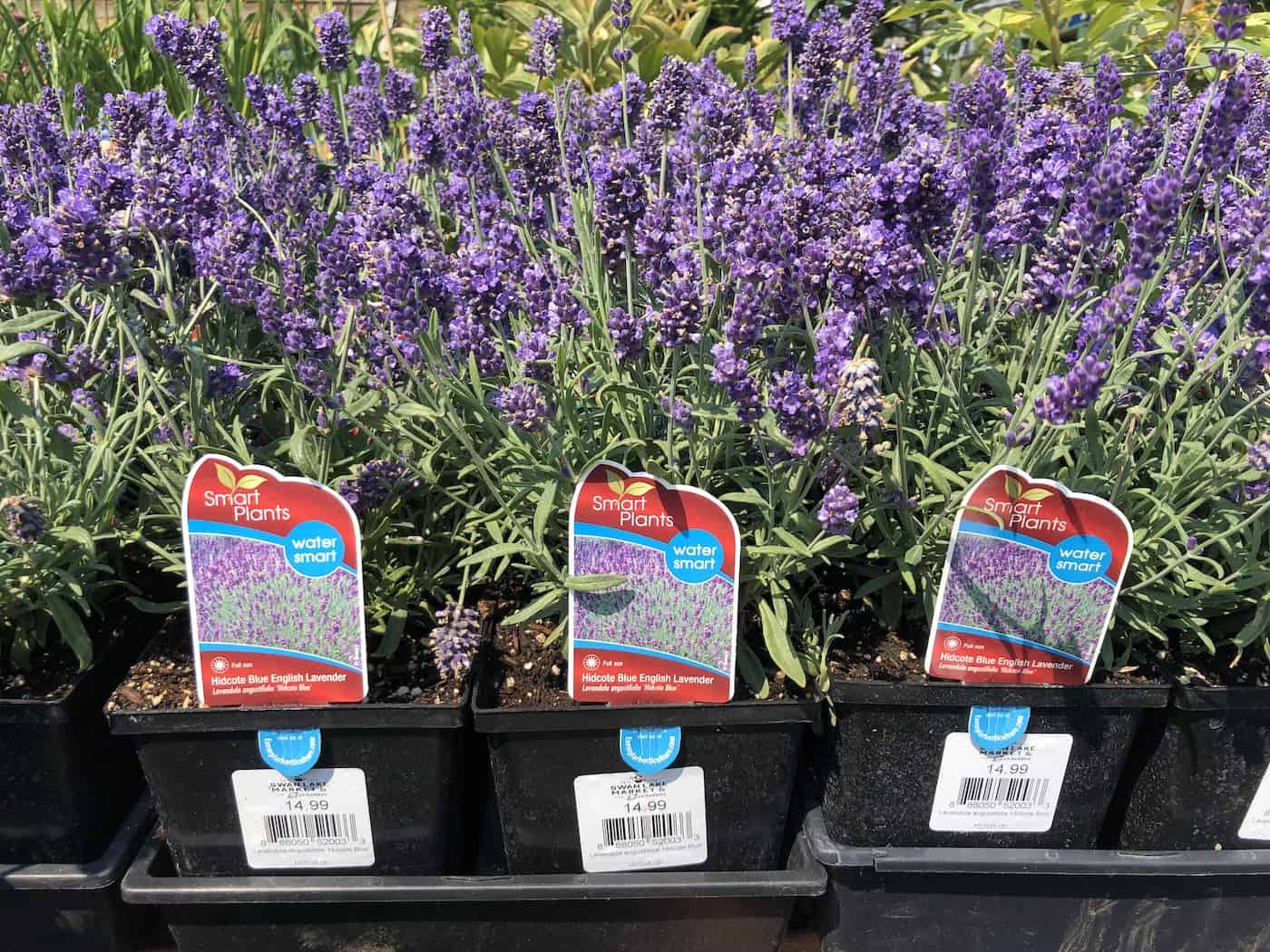
Where to buy Hidcote lavender plants
Lavandula angustifolia ‘Hidcote’ is widely available from local nurseries, larger garden centers, and online plant shops. Hidcote Lavenders are sometimes labeled as ‘Hidcote Blue Lavender’ or ‘Hidcote Purple Lavender.’ Related yet different varieties include the pink-flowered ‘Hidcote Pink Lavender,’ ‘Hidcote White Lavandin,’ and ‘Hidcote Giant Lavandin.’
Where to plant Hidcote lavender
Hidcote lavender can be grown in hardiness zones 5-9. This variety is a cultivar of English Lavender, which is native to the Mediterranean but has enough cold hardiness to be grown in cooler climates such as the UK and cooler North American climates. Plants grown in the coldest winter temperature zones may require extra winter care, such as winter protection covers or mulch.
Hidcote lavender should be planted in a full sun location with well-drained soil. In terms of full sun, the plant’s leaves should receive at least 6-8 hours of full sun per day. Well-drained soil at the planting site allows excess water to pass through easily, leaving small air pockets in the soil voids (and avoiding excessive moisture). Avoid planting Lavender anywhere water tends to pool after rainfall. If you must plant in clay soil, amend the soil with organic compost, peat, and/or coconut coir to create a lighter, drier mix.
English lavender also grows best in a neutral to alkaline soil pH, although this variety is somewhat tolerant of slightly acidic soil. Overly acidic soil should be amended with garden dolomite lime prior to planting.
Hidcote is one of the smaller varieties of English Lavender, making it a good choice for a low-growing small evergreen shrub or even as a container plant on the patio or beside the front door. The bushy compact-mounded form of this plant is also well-suited to edging around larger beds or as a fragrant perimeter lavender hedge along a walkway. Lavender is both deer-resistant and rabbit-resistant.
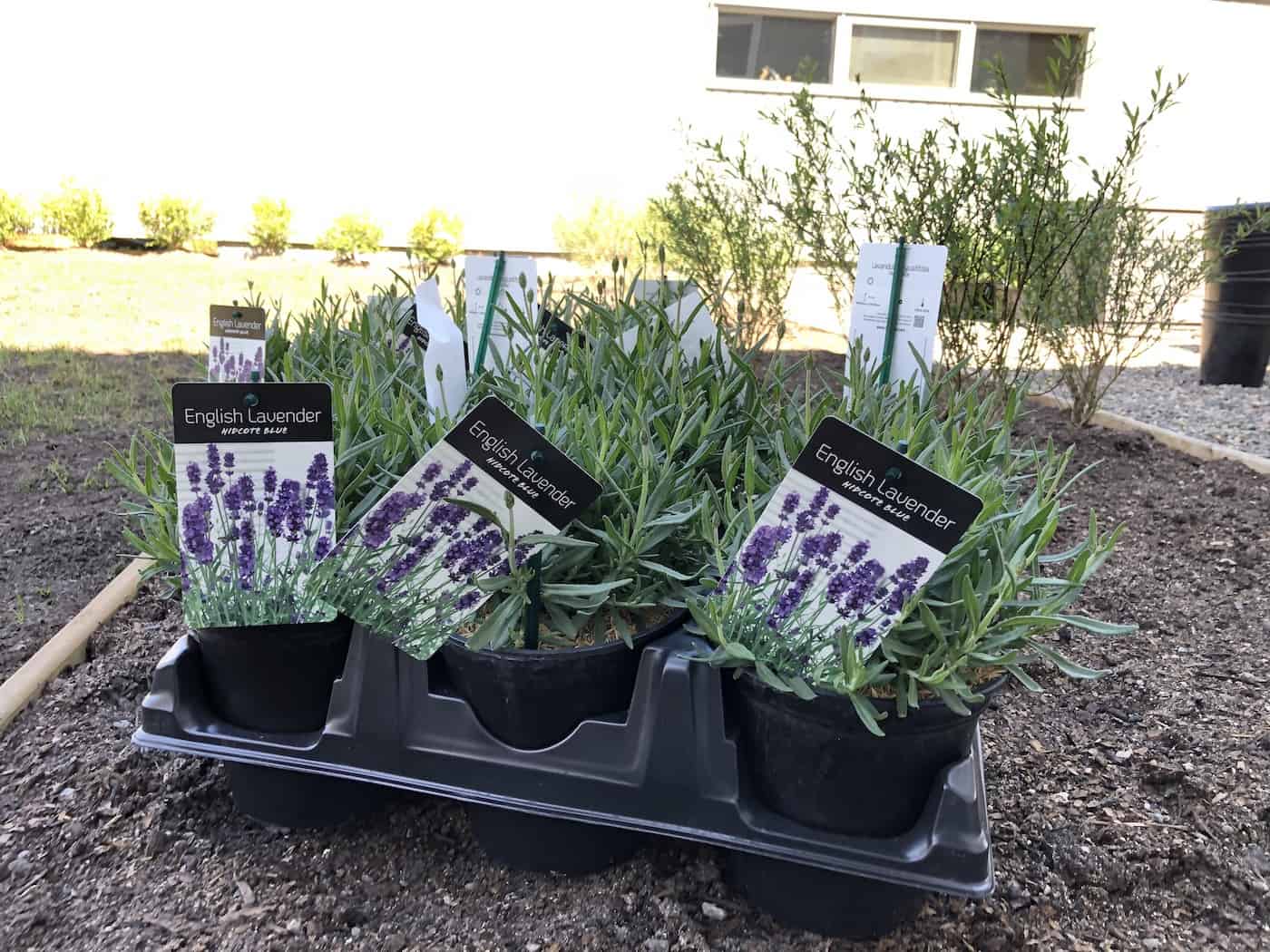
How to plant Hidcote lavender
Hidcote lavender is best planted in early spring or in the fall. Transplanting is usually most successful when done early in the morning, on a cloudy day or when the planting area is otherwise shielded from harsh direct sunlight. Planting outside of the proper planting time may stress the plant and delay the growth of the roots into the surrounding soil.
Here are the basic steps for planting Hidcote lavender:
- Dig a hole for the plant’s root ball. The hole should be about twice as wide as the pot the plant was sold in but no deeper than the potting soil inside the planter. Pour some water into the hole and watch to ensure the water drains down easily into the soil.
- Pull the Hidcote Lavender plant out of the nursery pot. Take a look at the roots, if not too many roots are visible on the outside of the root ball, it can go straight into the planting hole. If there are thick white roots circling around the root ball (particularly at the bottom), you may wish to gently loosen the root ball and coax the thicker roots out of the circular pattern and into more of an outwards direction.
- Backfill the planting hole gently around the sides of the Lavender plant’s root ball. Use the soil that came out of the hole to backfill it, gently tamping it down as you go. If your soil is nutrient poor, you may wish to mix an organic transplanting fertilizer into the soil used to backfill the planting hole.
- Apply a ~1″ thick layer of compost as an organic mulch over the surface of the soil to keep weeds down, buffer soil from temperature swings, and provide a natural source of slow-release plant nutrients.
- Water the newly planted Lavender thoroughly after planting.
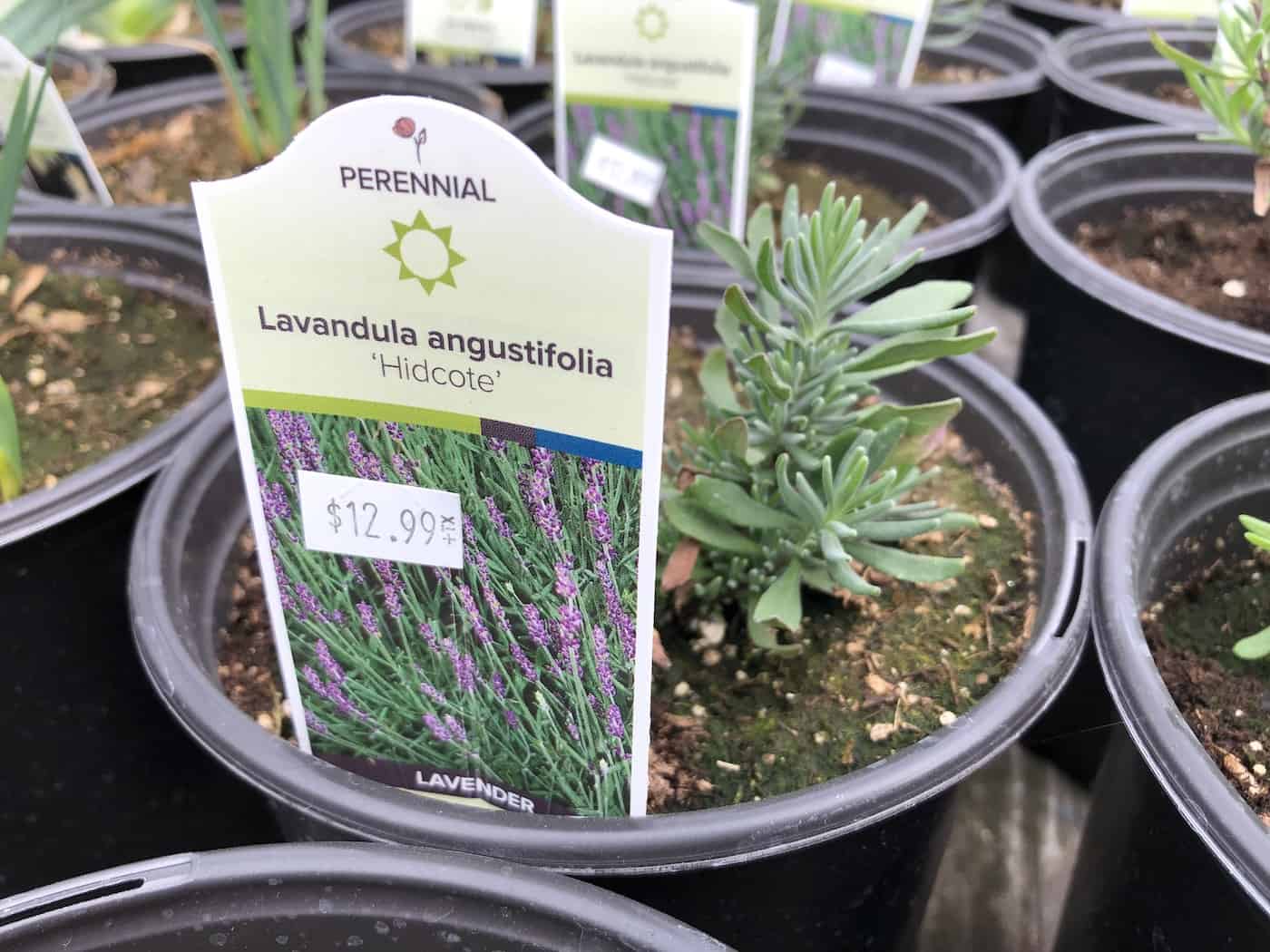
How to grow & care for Hidcote lavender
Hidcote Lavender is a relatively low-maintenance plant to grow and care for.
Watering Hidcote lavender
Hidcote Lavender is relatively drought-tolerant once established in the landscape, but it does take a year or two for the roots to grow enough to support the plant in dry soil. Carefully monitor the soil moisture for a year after planting and water whenever the top inch of soil dries out.
Watering may be infrequent in moist spring/fall weather but the plants may require irrigation several times a week during heat waves or dry summer weather. Watering right at the soil level (such as with drip irrigation) is preferable to overhead watering as moistening leaves regularly can lead to fungal disease. Disease can be more of a problem in wet climates with high humidity.
Once the plants have well-established perennial roots in the surrounding soil, Hidcote Lavender tends to be quite tolerant of dry soil, and the plants don’t need regular watering in most conditions. Don’t overwater established plants as overly damp soil can stress the plant and potentially lead to root rot if the soil is poorly drained. Limit supplemental watering except in overly arid climates. Hidcote Lavender tends to be low maintenance once established in the landscape.
Fertilizing Hidcote lavender
Hidcote Lavenders may need to be fed with an organic fertilizer when the soil is nutrient-deficient. While the organic mulch applied during planting will likely help, some soils do require added nutrients (see garden soil testing to learn how to test soil for plant nutrients).
A lavender plant can be fed with fertilizer in the spring after the plants break winter dormancy and again in late summer after flowering has finished. Timing fertilizing will depend on the USDA planting zone number, with cooler climates waiting for the ground to thaw prior to fertilizing plants and very warm winter areas fertilizing as early as late winter. Follow the instructions on the specific fertilizer product for application details. In planting locations with naturally acidic soil, you may also wish to apply dolomite lime in the spring or in autumn.
Pruning Hidcote lavender
As a cultivar of English Lavender, Hidcote plants require annual pruning for best results. Hidcote Lavender is most commonly pruned in the weeks following flowering or in early autumn. This annual pruning is generally quite significant on mature plants, removing 1/3 to 1/2 of the plant’s aboveground foliage. These plants may also be lightly sheared along the sides in the spring if planted in a formal hedge. Spring is also a good time to look for and remove any stems that died during the winter.
To prune Hidcote Lavender in late summer/early fall, cut the entire plant back by 1/3 to 1/2 of its size. For instance, if most stems with leaves are about 18″ long, they can be cut back to 9″-12″ long each. Also, remove any stems that are dead, dying, diseased, or damaged. These stems can be removed right down to the base of the plant. If you’re unsure about timing, here is a detailed article all about when to cut back lavender.
If Hidcote Lavender is not pruned hard annually, these plants tend to develop woody centers that are difficult to shape in future years. Gardeners who prefer lower-maintenance plants may consider planting French Lavender or Spanish Lavender instead of English Lavender. These species are different types of lavender that don’t require heavy annual pruning.
Harvesting Hidcote lavender
Hidcote Lavender is typically harvested in early summer as the first flowers start to bloom on the plant. Harvested flowers can be dried on the stalk, used in floral bouquets, added to potpourri, or used in cooking (especially desserts).
When to harvest Hidcote lavender
Timing the lavender harvest depends upon how the lavender will be used. Most gardeners try to harvest Hidcote lavender as the first flowers on the spike open, as this is when the lavender can be used in multiple different applications.
If whole flower spikes are desired, harvest the Hidcote lavender in early summer after the first two flowers on the spike have bloomed. Lavender harvested at this stage can be used in fresh floral arrangements that will last a week or two, or it can be dried into fragrant dry lavender spikes.
If lavender is left to flower on the plant, it can still be harvested for immediate display in bouquets or dried for use in potpourri or scented lavender sachets. Lavender buds that have flowered tend to fall off the stem and are not commonly used for dried flower spikes. That said, the dried flowers are wonderfully fragrant and perfectly suited to loose applications like potpourri or soap making.
How to harvest Hidcote lavender
Harvest your Hidcote Lavender flower spikes in the morning. Wait until the morning dew has dried but try to harvest the flowers before the heat of the day becomes too intense. Use a clean sharp pair of scissors or pruning shears to cut each stem off the plant. You can remove the stem down to half its height. For instance, a flower stem that stretches 20″ from ground level to the tip of the flower spike can be cut to 10″ long in most cases.
Using Hidcote lavender
Hidcote Lavender is well suited to use in potpourri, essential oil production, perfume, and even in culinary applications. English Lavender is commonly used in baked goods, summer drinks, and specialty dessert syrups.
Similar lavender varieties to consider
If Hidcote lavender is unavailable or otherwise not the cultivar of choice, there are plenty of other lavender varieties to consider. For instance, Buena Vista Lavender is a popular choice for those looking for sweetly-scented lavender who also want the flowers to be dark purple-blue. Foveaux Storm lavender is a similarly-sized plant with very dark violet flowers. The lavandin variety Grosso also has dark purple flowers.
Hidcote Lavender vs Munstead Lavender
Hidcote lavender is commonly compared to Munstead lavender. Both cultivars are heirloom varieties bred in the UK. Both types tend to reach about 24″ (60 cm) tall and both have dark purple flowers. Munstead is thought to be several decades older than Hidcote. In general, Mustead Lavender is typically preferred for culinary gardens while Hidcote is preferred for ornamental or scented gardens.
Common plant diseases affecting Hidcote lavender
While English lavender plants are generally quite hardy, there are several fungal, bacterial, and viral diseases that can affect them.
Fungal disease like leaf spot fungi (Septoria lavandulae) and root rot caused by Phytophthora mold can affect Hidcote lavender. This generally happens in areas with high rainfall and/or frequent overhead watering. Root rot typically also occurs when the soil does not drain out excess water. Take care to ensure soil is draining well and that air is circulating around the base of the plant.
English Lavender plants are sometimes affected by the Alfalfa Mosaic Virus, which creates a yellow “mosaic” pattern on the leaves of affected plants. This virus is thought to be spread by aphids and/or non-sterile pruning tools.
Common garden pests affecting Hidcote lavender
Hidcote Lavender plants are sometimes attacked by garden pests like aphids and mealy bugs. These bugs can generally be sprayed off the plant with a sharp stream of water but may require an organic pesticide spray once the pests have become established.
Mammals rarely attack lavender due to its very strong scent. Deer generally avoid it completely, especially if the plant has flowers on it. Young plants may be attacked by rabbits and other smaller burrowing mammals. Rabbits tend to dig around the roots rather than attack the foliage or flowers.


